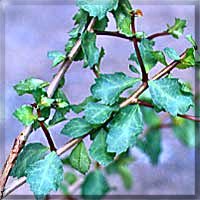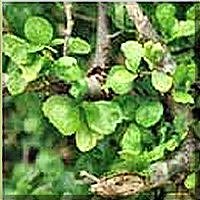

Commiphora mukul


Commiphora mukul
Edible Parts Commiphora mukul Engl. (synonyms: Commiphora wightii and Balsamodendron mukul), is a small tree of the Burseraceae family that is indigenous to India. It grows wild in the semi-arid states of Rajasthan, Gujarat, and Karnataka in India. The Commiphora mukul tree has an ash-colored bark that comes off in rough flakes exposing the under bark which also peels off in thin papery rolls exuding a yellowish resin called Guggul. Guggulipid is the extract of the gum resin Guggul. A healthy tree yields 250-500 grams of resin in one season. Guggul plants typically begin yielding resin after five years during the winter months. It has been used for many years as a hypocholesterolemic agent in India.
One of the best known Ayurvedic herbs in India is gugul, the A resin (organic substances that exude from trees and plants) from the Commiphora mukul tree. After 2,500 years of successful use, this herb from north-central India is making its way into the arsenal of alternative practitioners. Modern medicine now knows that the Ayurvedic doctors of the past had accurately characterized many health abnormalities in ancient texts such as the Charak Samhita. At that time, the gugul tree (Commiphora mukul) was scraped to yield the gummy resins called "gugul." These resins were then traditionally used for a variety of imbalances such as intestinal inflammation, diarrhea, urinary disorders and more specifically rheumatism and obesity. Indians and Europeans are still using gugul for many of the same conditions for which it was prescribed in the past (Science Age, 7-1987). The high-quality standardized gugul extracts of today make it a viable alternative in the treatment of cholesterol abnormalities and obesity. Before you make any changes to your diet, however, you must confer with your physician.
Pharmacology:
Gugal and Glucosamine - The active component of gugul is the sterols E- and Z-gugulsterone. These compounds have been studied for a variety of metabolic effects, but gugulsterones have been noted for their anti-inflammatory effect. In Jammu (a north Indian state), the Regional Research Laboratories investigated gugul for its effect on rheumatic diseases and found it to be free of any "adverse and undesirable side-effects." Another nutrient used by many individuals seeking relief from inflamed joints is glucosamine sulfate, which is extremely popular for people coping with joint disorders and is one of the treatments of choice for many naturopathic doctors treating arthritic patients. A variety of glucosamine forms serve as the building blocks of connective tissue glycoproteins, but glucosamine sulfate is the most extensively studied. Glucosamine sulfate is recognized in Europe as a chondroprotective agent, which is a substance that increases chondrocyte anabolic activity (International Journal of Tissue Reactions, vol. 14(5) pg. 231, 1992). Although people report excellent results in the long run from glucosamines, they exert no anti-inflammatory activity.
Gugal and Triglycerides - Because of a study in Drugs of Today, there has been some interest by cholesterol-researchers in gugul. In that study, 79 percent of 245 patients who had high cholesterol - results: 27 percent drop in cholesterol and 22 percent drop in triglyceride.
Gugal and Lipoproteins - These days we have a fervent dietary school of thought committed to sharply reducing fats in our diet. As a nation we have gotten so fat (33 percent of our population is obese), that it is obvious that we must cut down our fat intake. Unfortunately, the American Heart Association and many other health pracitioners are missing a key item: that lowered fat intake can result in declines in HDL (good, cholesterol-reducer) as well as LDL and Very Low Density Lipoproteins. Also, less lipid-soluble vitamins such as beta-carotene, retinol (vit. A), tocopherol (vit. E), and vitamins D and K would be absorbed.
Gugal and Obesity - Ayurvedic practitioners also used gugul for weight-loss. It was thought then that the herb acted as a metabolic tonic, but its mechanism of action was unknown. It is now known through research that gugul has an effect on the thyroid gland. In short, gugul raised the levels of circulating thyroid hormones, which may account for its ability to regulate obesity and cholesterol levels.